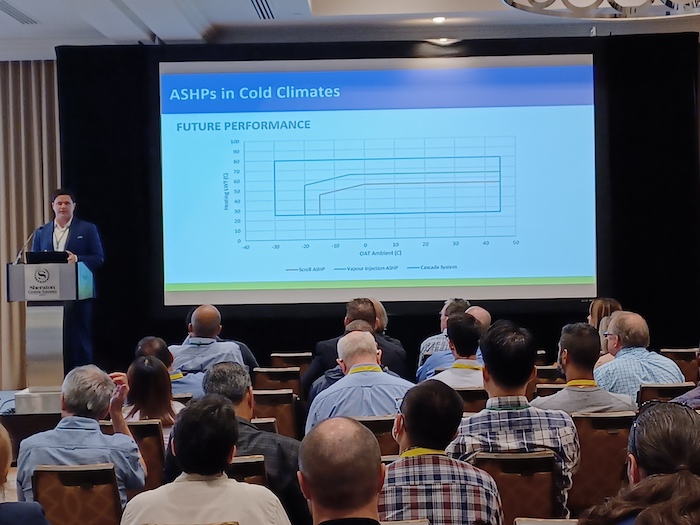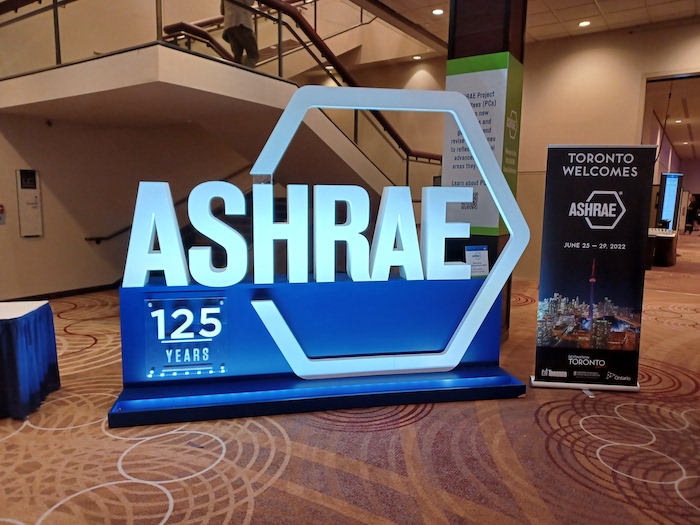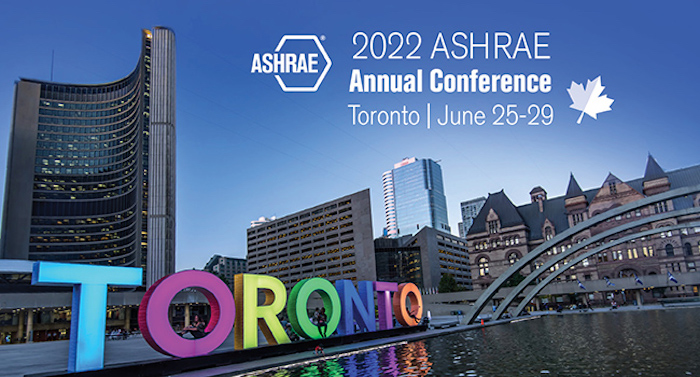
In-Depth
Ventilation conferences in Toronto highlight low-carbon HVAC
July 11, 2022
By
Peter Saunders

In June, two conferences at the Sheraton Centre Toronto showcased ventilation innovations, challenges and opportunities, both with the involvement of the American Society of Heating, Refrigerating and Air-Conditioning Engineers (ASHRAE).
The first, running from June 22 to 24 (following a June 21 welcome reception), was the ASHRAE-hosted 13th edition of the Industrial Ventilation Conference, which focuses on advances in contaminant control. The original conference was hosted by the University of Toronto (U of T) and the Occupational Hygiene Association of Ontario (OHAO) in 1985, at the Royal York Hotel. Since then, the event has taken place every three years, rotating locations between North America, Europe and Asia, although this year’s ‘homecoming’ was delayed from August 2021 due to COVID-19.
This year’s theme was low-carbon technology. The educational program, including conference papers, seminar presentations and workshops, spanned four tracks: industrial ventilation for process applications; industrial HVAC innovations; modelling; and COVID-19. Presenters tackled ventilation challenges for everywhere from dental clinics to portable lunchrooms to hazardous spaces in oil, gas and nuclear facilities.
The specialized conference brought in close to 200 attendees from 17 countries, including engineers, practitioners, researchers, scientists and regulatory personnel. Most of the presenters represented academia or government departments, but there were also consulting engineers from Canadian firms like RWDI, CDML and Stantec.
Next came the ASHRAE Annual Conference, running from June 25 to 29 and coinciding with the 100th anniversary of the society’s Toronto chapter. Among local highlights, registrants enjoyed technical tours of Enwave’s Deep Lake Water Cooling (DLWC) System, which helps reduce heat for many of Toronto’s downtown buildings in an energy-saving, low-carbon method, and the conference venue itself, which underwent a $120-million renovation in 2015 that added one of the largest variable refrigerant flow (VRF) systems in North America at the time.
ASHRAE reports more than 1,800 industry professionals, building systems engineers, architects, contractors and students attended the conference and committee meetings, both in-person and virtually.
The technical program sessions featured many presenters from Canada, including consulting engineers:
- Kurt Monteiro, P.Eng., of Smith + Andersen joined Will Rea, P.Eng., of HTS Engineering in presented the conference’s top session, which was about designing for air-source heat pumps in cold climates.
- Mudit Srivastava, Keith Davidge, Mike Godawa, Jamie Dabner, Pablo Casuso and Bhavin Degadwala of Integral Group highlighted the benefits of integrated project delivery (IPD), the HVAC system for the Toronto and Region Conservation Authority’s (TRCA’s) new headquarters (HQ), strategies to achieve a net-zero carbon mass-timber academic building and the futureproofing of an emergency paramedic facility in Toronto.
- Peter Adams, P.Eng., of Morrison Hershfield described the prevention of condensation at a cold and leaky water treatment plant.
- Veronica Ochoa, Hassan Bokhary, Mohammad Fakoor and Maddy Kennedy-Parrott of RJC Engineers outlined the impacts of process loads on thermal energy demand intensity (TEDI) and analyzed acceptability limits for determining overheating risks for passively cooled buildings.
- Goncarlo Pedro, Duncan Phillips and Mike Carl of RWDI covered the benefits and pitfalls of using machine learning in wind estimation for microclimate studies, the importance of managing pressure loss in data centres, the challenges of keeping naturally ventilated elevator cores dry in hot, humid climates and lessons learned from COVID-19 mitigation measures in more than 100 buildings.
- David Shipley, P.Eng., of Posterity Group Consulting debated engineers’ duty to address climate change adaptation and resilience.
- Lianne Cockerton, P.Eng., of Martin Roy et Associés (MRA) aimed for sustainability and energy efficiency in a cold climate through integrated design.
- Xin Qiu of SLR/Novus Environmental discussed recent climate science developments and measurements.

The ASHRAE Annual Conference’s most popular session was about designing for air-source heat pumps in cold climates. Photo by Peter Saunders.
Other speakers hailed from academic circles:
- Amir A. Aliabadi of Ontario’s University of Guelph addressed building energy modelling in relation to climate change.
- Bicheng Xing and Carey Simonson of the University of Saskatchewan and Lei Zhang of the University of Regina joined Adesola Olufade of Saskatoon-based AccuraSee Instruments to assess liquid-to-air membrane energy exchangers and fluid dynamic gauging instruments.
- Monica Brands, Khalid Ullah, Adrian Wu, Amirali Rok and Alan S. Fung of Toronto Metropolitan University (formerly known as Ryerson University) offered HVAC strategies for mitigating the spread of COVID-19 in Canadian long-term care (LTC) homes.
- Liam O’Brien, Luminita Dumitrascu and Ian Beausoleil-Morrison of Ottawa’s Carleton University described the results of a ‘living lab’ approach to studying office building occupants and presented modelling for a sub-slab thermal storage system for coupling to a heat pump.
- Chen Feng and Sanjeev Chandra of the University of Toronto (U of T) joined Redmond Hum and Marcelo Acosta of Toronto-based Armstrong Fluid Technology to describe heat load estimation for a brazed plate heat exchanger.
- Yufeng Deng, Seungjae Lee, Marianne Touchie, Jamie Fine and Cara H. Lozinsky of U of T revealed potential driving factors of hold behaviours of smart thermostats using logistic regression and clustering and studied the reduction of indirect inter-suite air flow in high-rise multi-unit residential buildings (MURBs).
- Zisis Ioanndis, Andreas Athienitis, Ted Stathopoulos, Stratos Rounis, Majd Moujahed, Liangzhu Wang and Danlin Hou of Montreal’s Concordia University presented a double-skin façade case study integrating semi-transparent photovoltaics (PVs) for various climates, evaluated approaches for developing building energy archetype models and considered the impacts of urban microclimates on building cooling loads in arid regions.
- Debby Veillette, Jean Rouleau and Louis Gosselin of l’Université Laval in Quebec City offered a practical method to account for different occupant behaviours during the design phase.
- Jeffrey Siegel and Sarah Haines of U of T and Carolynn Kerr of the University of Guelph discussed air filters and their usefulness during the COVID-19 pandemic.
- Marianne Grimard-Conea and Michele Provost of Polytechnique Montreal explored the water quality issue of whether flushing, superheating and shock chlorination can control legionella after extended stagnation.
There were also representatives of government, manufacturers and other businesses:
- Alex Lachance, Justin Tamasauskas, P.Eng., Stéphanie Breton, Sarah Mollier, Charles-Antoine Deslauriers and Martin Kegel, P.Eng., with Natural Resources Canada (NRCan) in Varennes, Que., profiled air-source heat pumps’ performance and electrical demand impacts on buildings, while their colleague John Scott described heat recovery successes and failures.
- Brent Huchuk, Farid Bahiraei and Saptak Dutta of the National Research Council of Canada (NRC) studied occupant behaviour and thermal comfort in small commercial buildings using smart thermostat data.
- Araz Ashouri, Farid Bahiraei and Scott Shillinglaw of NRC and Christopher McLellan of NRCan presented a data-driven model for virtual energy auditing.
- Wade Reda of Siemens in Toronto addressed cybersecurity in a Division 25 framework.
- Mike Koupriyanov of Price Industries in Winnipeg explained design nuances for an airport terminal.
- Jayson Bursill of Delta Controls discussed in-situ testing of model-based predictive control (MPC) in an institutional building.
- Jonathan Berney of Cimco Refrigeration discussed how effective refrigeration system heat recovery can reduce carbon dioxide (CO2) emissions.
- Daniel Coursol of l’Association Unie Local 144 in Pointe-aux-Trembles, Que., covered integration design from conception to occupancy.
- Sophie Marquet of Blouin Tardif Architecture Environnement provided an architect’s perspective on facilitating IPD.
- Orvil Dillenbeck, P.Eng., of Canadian Nuclear Laboratories (CNL) discussed getting a building automation system (BAS) up and running and stabilizing its performance to improve energy efficiency.
- Former ASHRAE president Darryl Boyce of Kemptville, Ont., Jayson Bursill of Delta Controls and Bill MacGowan, P.Eng., of Cisco Systems Canada explained how ASHRAE’s new HQ building can ensure a high-quality occupant experience while working toward net-zero operations.
Speaking of its presidency, ASHRAE used the event to introduce its new leader for the next year, Farooq Mehboob, along with executive committee officers and directors.
“It’s imperative we continue to hunger for and seek information about our market, our changing world and our technological advances,” said Mehboob in his presidential address. “Embracing change will infuse a new dynamism in our society at all levels.”
ASHRAE’s next annual conference is scheduled for June 24 to 28, 2023, in Tampa, Fla. (following its previously announced winter conference from Feb. 4 to 8, 2023, in Atlanta, Ga.).
Print this page

